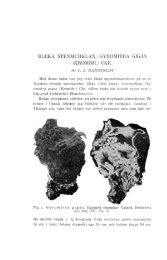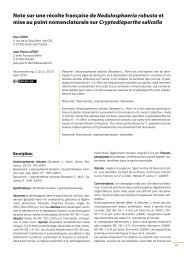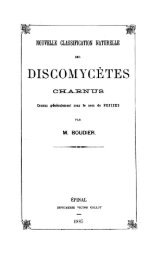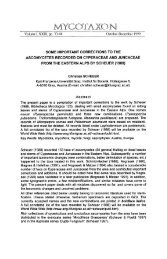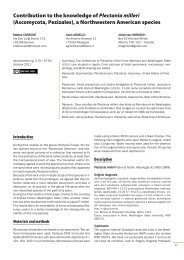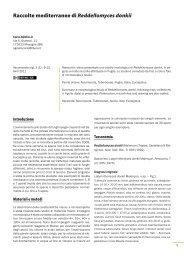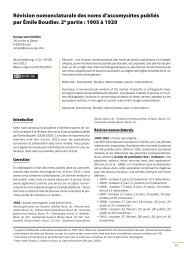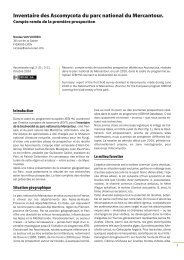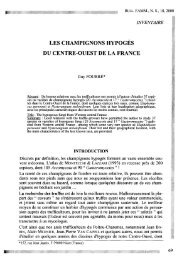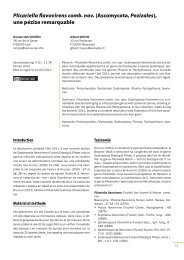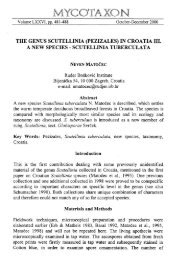Tuber asa and T. gennadii. A close morphological ... - Ascomycete.org
Tuber asa and T. gennadii. A close morphological ... - Ascomycete.org
Tuber asa and T. gennadii. A close morphological ... - Ascomycete.org
Create successful ePaper yourself
Turn your PDF publications into a flip-book with our unique Google optimized e-Paper software.
<strong>Tuber</strong> <strong>asa</strong> <strong>and</strong> T. <strong>gennadii</strong>. A <strong>close</strong> <strong>morphological</strong> study of two<br />
species often confused in the past with a brief historical<br />
bibliographic summary<br />
Carlo AGNELLO Vasileios KAOUNAS<br />
Via A. Gramsci 11 Sokratous 40<br />
I-72023 Mesagne TK 19016, Artemis Attiki - Greece<br />
agnellocarlo@libero.it bkaounas@yahoo.gr<br />
<strong>Ascomycete</strong>.<strong>org</strong>, 3 (4) : 65-74.<br />
Décembre 2011<br />
Mise en ligne le 21/12/2011<br />
Introduction<br />
The two species treated in this paper share similar habitats<br />
while remaining <strong>morphological</strong>ly very different. The habitat<br />
of the collections is Mediterranean woods at low altitudes<br />
or even directly by the sea <strong>and</strong> even on s<strong>and</strong>y soil in various<br />
mixtures of Pinus halepensis, P. pinea, Quercus coccifera,<br />
Juniperus oxycedrus as well as various species of Cistaceae<br />
in broad opening. Greek collections evidence that T.<strong>gennadii</strong><br />
<strong>and</strong> T. <strong>asa</strong> co-exist <strong>and</strong>, in one case, within a few centimeters;<br />
we also found Picoa sp. <strong>and</strong> Terfezia sp. in the same<br />
habitats. MONTECCHI et al. (2001) published a similar study.<br />
Our discussion adds important data for both <strong>Tuber</strong> species<br />
<strong>and</strong> integrates information published on this subject since<br />
2001. The decision to list the chronological history of the<br />
two species together may seem chaotic, but we decide to do<br />
so because over past years these two species have been<br />
confused. Part of this confusion arises because some past<br />
mycologists disregarded the holotypes that set the st<strong>and</strong>ard<br />
for morphology characterizing the species.<br />
Materials <strong>and</strong> methods<br />
Morphological characters are described from fresh specimens.<br />
Microscopic characters were studied from sections<br />
mounted in water to observe pigments <strong>and</strong> to measure<br />
structures. Melzer’s reagent <strong>and</strong> cotton blue were used to<br />
Summary: The authors describe <strong>Tuber</strong> <strong>asa</strong> <strong>and</strong> T. <strong>gennadii</strong>, showing the differences<br />
between the two species. A historical overview that highlights how the species have<br />
been often confused in the past is also given. The study is accompanied by images<br />
in their habitat <strong>and</strong> by microscopical photographs, drawings <strong>and</strong> original plates.<br />
Keywords: Ascomycota, <strong>Tuber</strong>aceae, hypogeous Pezizales, taxonomy, Greece, Italy.<br />
Résumé : les auteurs décrivent <strong>Tuber</strong> <strong>asa</strong> et T. <strong>gennadii</strong>, montrant les différences<br />
entre les deux espèces. Un aperçu historique qui met en lumière comment les espèces<br />
ont été confondues dans le passé est également donné. L’étude est accompagnée<br />
par des images dans leur habitat et par des photographies microscopiques,<br />
des dessins et des planches originales.<br />
Mots-clés : Ascomycota, <strong>Tuber</strong>aceae, Pezizales hypogés, taxinomie, Grèce, Italie.<br />
highlight the ornamentation <strong>and</strong> Congo red for the walls of<br />
cells. Spores dimensions are based on at least 60 r<strong>and</strong>omly<br />
selected spores, excluding ornamentation. Our descriptions<br />
are conform to the holotypes of <strong>Tuber</strong> <strong>asa</strong> <strong>and</strong> T. <strong>gennadii</strong> at<br />
the Muséum national d’histoire naturelle, Paris (PC), as described<br />
by J. Trappe (personal communication).<br />
Taxonomy<br />
<strong>Tuber</strong> <strong>asa</strong> Tul. & C. Tul., Fungi Hypogaei: 149 (1851).<br />
≡ <strong>Tuber</strong> <strong>asa</strong>-foetida Lespiault, manuscriptum in schedis propris.<br />
Original diagnosis<br />
Fungus globosus vulgo nucis magnitudine, undique irregulariter<br />
gibboso-sulcatus, sordideque luteolus. Peridium leve, tenue, glebae<br />
valde haerens. Caro firma griseo-lutea venis labyrintheis albidis<br />
vel griseis, anastomosantibus, nec non lineis angustissimis<br />
raris nigrescentibus marmorata. Sporangia ovato-rotundata, sporis<br />
globosis (et quidem sphaericis ac 0mm,032-042 diametro metientibus)<br />
elegantissime reticulatis (maculis saepius hexagonis)<br />
maturitatisque tempore saturate luteo-fuscis seu rufulis foeta. Odor<br />
gravissimus illius Asae foetidae admodum aemulus, penitus intra<br />
paucos dies evanescit. (Lespiald.) Raro effoditur in sabuletis prope<br />
Neracum, mense januario. (Lespiald.) Specimina sicca sectaque<br />
vidimus quae Balsamiam vulgorem quodammodo mentiuntur.<br />
65
66<br />
Fig. 1 – <strong>Tuber</strong> <strong>asa</strong>. Collection 2008 from Schinias (Greece) – photo: V. Kaounas.<br />
Fig. 2 – <strong>Tuber</strong> <strong>asa</strong>. Immature collection under C. monspeliensis ( S.Pancrazio S.no-Italy) – photo: C. Agnello.
Fig. 3 – <strong>Tuber</strong> <strong>asa</strong> (photos: C. Agnello)<br />
A. Peridium in Congo red.<br />
B-C-D. Asci <strong>and</strong> spores in Congo red.<br />
E-F. Asci <strong>and</strong> spores in cotton blue.<br />
67
68<br />
Description<br />
Ascomata irregularly globose, tuberiform, 2–5 (7) cm broad,<br />
nearly smooth, ochraceous yellowish with reddish brown<br />
spots. Peridium entirely by parallel or interwoven hyphae, up<br />
to 5–6 μm broad. Gleba yellowish grey to beige with whitish<br />
veins. Odor generally unple<strong>asa</strong>nt; of stale, rotten wood but<br />
sometimes ple<strong>asa</strong>nt.<br />
Asci r<strong>and</strong>omly embedded in the fertile tissue, subglobose to<br />
broadly ellipsoid, hyaline, with or without a short stem, 70–<br />
95 μm broad, 1–4 (5) spored. Spores globose or broadly ellipsoid,<br />
25–45 × 22–40 μm, Q < 1.2, yellowish brown at<br />
maturity; ornamentation is an alveolate reticulum of polygonal<br />
meshes, the ridges 1–3 (5) μm tall.<br />
Season, distribution <strong>and</strong> habitat<br />
Hypogeous or emergent, autumn to spring in Mediterranean<br />
ecosystems at low elevations, in dry <strong>and</strong> s<strong>and</strong>y places, in<br />
deserts <strong>and</strong> beaches, under Cistus incanus, Cistus salvifolius,<br />
<strong>Tuber</strong>aria sp., Helianthemum sp., Ephedra sp., among<br />
P. halepensis, Juniperus oxicedrus, etc.<br />
Collections examined (partial)<br />
GREECE: 09.05.2008, Schinias (Attika) alt. 5 m; 03.01.2011,<br />
Rafina (Attika), alt. 60 m; 22.02.2011, Nea Makri (Attika)<br />
alt. 50 m. Vasileios Kaounas collected <strong>and</strong> identified all<br />
Greek specimens which are conserved in his personal herbarium.<br />
ITALY: 17.04.2008, Ginosa Marina (Apulia) at sea<br />
A<br />
Fig. 2 – <strong>Tuber</strong> <strong>asa</strong>. Particular of gleba; collection 2008<br />
from Ginosa Marina (Italy) – photo: C. Agnello.<br />
level, leg. Emanuele Pepe, det. C. Agnello; 08.12.2008, Cannole<br />
(Apulia), alt. 30 m, leg. Eugenio Murciano, det. E. Murciano<br />
& C. Agnello; 20.02.2009, S. Pancrazio S.no (Apulia),<br />
alt. 50 m, leg. <strong>and</strong> det. Adolfo Delle Donne & C. Agnello;<br />
11.04.2009, M<strong>and</strong>uria (Apulia), alt. 100 m, leg. Lucio Maraschio,<br />
det. C. Agnello. All Italian collections are conserved<br />
in C. A. personal herbarium.<br />
Tab. 1 – <strong>Tuber</strong> <strong>asa</strong>. A. Peridium <strong>and</strong> part of gleba. B. Spores – Drawing: C. Agnello.<br />
B
Notes<br />
This species can be confused with T. oligospermum (Tul. &<br />
C. Tul.) Trappe because it often shares the same habitat.<br />
T. oligospermum differs microscopically from T. <strong>asa</strong> by its totally<br />
globose spores (that’s why the species was originally<br />
described as Terfezia oligosperma Tul. & C. Tul.), asci with or<br />
without short-stalks, peridium with hyphae interwoven so<br />
that the section can appear to consist of elongated hyphal<br />
cells mixed with small sphaerical cells, but in reality those<br />
are cross sections of elongated hyphae. T. <strong>asa</strong> fruits in October<br />
or November to early June. In our experience, T. <strong>asa</strong><br />
contrasts with many other <strong>Tuber</strong> species in that immature<br />
specimens rarely mature when stored in a refrigerator.<br />
<strong>Tuber</strong> <strong>gennadii</strong> (Chatin) Pat., Bull. Soc. mycol. Fr., 19: 255<br />
(1903)<br />
≡ Terfezia <strong>gennadii</strong> Chatin, Bull. Soc. bot. Fr., 43: 611<br />
(1896).<br />
= <strong>Tuber</strong> lacunosum Mattir., Malpighia, 14: 53 (1900).<br />
≡ Delastreopsis <strong>gennadii</strong> (Chatin) Reichert, Palestine J.<br />
Botany, 4: 198 (1944).<br />
≡ Loculotuber <strong>gennadii</strong> (Chatin) Trappe, Parladé & I.F. Alvarez,<br />
Mycologia, 84(6): 927 (1992).<br />
A<br />
Original diagnosis<br />
Troisième sorte. Quiza. <strong>Tuber</strong>cules fort petits, du poids de 8 à 15<br />
grammes. Périderme jaunâtre. Chair d’un gris brun assez foncé,<br />
ferme, avec d’assez fines marbrures blanches, odeur et saveur peu<br />
sensibles, nullement alliacées. Sporanges allongés (rappelant<br />
ceux de <strong>Tuber</strong> magnatum ou Truffle à l’ail de Piemont), bispores,<br />
rarement trispores; spores rondes, du diamètre de 45 μ à 51 μ,<br />
parfois ellipsoïdes, comme dans les <strong>Tuber</strong> et Tirmania, avec des<br />
diamètres de 36 μ sur 46 μ.<br />
Description<br />
Ascomata irregularly globose, tuberiform, 1–4 cm broad,<br />
smooth or pubescent in places, greyish yellow with ochraceous<br />
brown spots, often with attached grains of s<strong>and</strong>. Peridium<br />
suprapellis a discontinous pubescence of septate<br />
yellowish hyphal tips 4–5 (7) μm broad; pellis a discontinous<br />
pseudoparenchyma of textura angularis with cells up to 15<br />
μm broad; subpellis of filamentous hyphae 5–7 (10) μm<br />
broad. Gleba initially greyish, later dark brown, with small<br />
but visible locules 0.2 to 1 mm broad, separated by thin whitish<br />
veins. Odor unple<strong>asa</strong>nt, resembling overripe cheese or<br />
naphthalene.<br />
Asci produced in a hymenium, clavate to ellipsoid, with a<br />
long-stemmed, 100–150 × 50–90 μm, hyaline, 1–3 (4) spored.<br />
Paraphyses septate, shorter or longer than the asci, with<br />
enlarged apex up to 3–6 (8) μm. Spores yellowish brown at<br />
maturity, globose, broadly ellipsoid or citriform (eye-shaped),<br />
32–42 (55) × 25–32 (35) μm, ornamented by ridges 3–5<br />
Tab. 2 – <strong>Tuber</strong> <strong>gennadii</strong>. A. Peridium <strong>and</strong> part of gleba. B. Spores – Drawing: C. Agnello.<br />
B<br />
69
70<br />
Fig. 5 – <strong>Tuber</strong> <strong>gennadii</strong>. Collection of mature specimens (Schinias, Greece) – photo: V. Kaounas.<br />
Fig. 6 – <strong>Tuber</strong> <strong>gennadii</strong>. Immature samples – photo: V. Kaounas.
Fig. 7 – <strong>Tuber</strong> <strong>gennadii</strong> (photos: C. Agnello, except C & D: D. Sofronis)<br />
A. Peridium in water. B. Asci <strong>and</strong> spore in cotton blue; peridium in Congo red.<br />
C. Paraphyses in Congo red. D. Spores in Congo red.<br />
E-F. Ascus <strong>and</strong> spores in cotton blue.<br />
71
72<br />
(7) μm tall which form a hexagonal reticulum. Focusing in<br />
some spores is possible to see a smallest double reticulum.<br />
Season, distribution <strong>and</strong> habitat<br />
Occurs in late autumn to spring, in groups, in underground,<br />
in Mediterranean ecosystems at low elevations in dry <strong>and</strong><br />
s<strong>and</strong>y places, on beaches, along with various Cistaceae (Cistus<br />
sp., <strong>Tuber</strong>aria sp., Helianthemum sp.) among Pinus<br />
pinea, P. halepensis <strong>and</strong> Quercus coccifera.<br />
Collections examined<br />
GREECE: 08.04.2009, 24.04.2009, 12.04.2011, Schinias (Attika),<br />
alt. 5 m. Vasileios Kaounas collected <strong>and</strong> identified all<br />
Greek specimens which are conserved in his personal herbarium.<br />
Note<br />
Macroscopically, the mature specimens of T. <strong>gennadii</strong> can<br />
not be confused with any other <strong>Tuber</strong> species because its<br />
gleba is crossed by locules. This is the reason why the new<br />
genus Loculotuber was published by ALVAREz et al. (1992).<br />
Microscopically, the main distinctive characters are the citriform,<br />
eye-shaped spores (about 30%) <strong>and</strong> the particular<br />
arrangement of asci around the hollow parts.<br />
Fig. 8 – <strong>Tuber</strong> <strong>gennadii</strong>. Particular of gleba; collection<br />
2011 from Schinias (Greece) – photo: V. Kaounas.<br />
Chronology<br />
•TULASNE & TULASNE (1851) describe <strong>Tuber</strong> <strong>asa</strong>, a species<br />
previously treated in a h<strong>and</strong>written paper by Lespiault as<br />
“<strong>Tuber</strong> <strong>asa</strong>-foetida”.<br />
•FERRY DE LA BELLONE (1888) claims to have been able to<br />
study twice <strong>Tuber</strong> <strong>asa</strong> <strong>and</strong> gives a faithful description.<br />
•CHATIN (1896) describes Terfezia <strong>gennadii</strong> based on gatherings<br />
made in the region of the Peloponnese (GR) <strong>and</strong><br />
sent by the Greek plant pathologist Panagiotis Gennadius<br />
(the name of the species is dedicated to him).<br />
•SACCARDO & SYDOW (1899), in Sylloge Fungorum XIV, translate<br />
from French into Latin the original diagnosis of Terfezia<br />
<strong>gennadii</strong> Chatin.<br />
•MATTIROLO (1900) publishes, after Sardinian <strong>and</strong> Sicilian<br />
collections, <strong>Tuber</strong> lacunosum sp. nov. (“<strong>Tuber</strong> lacunosus”),<br />
adding to the extensive description a beautiful plate made<br />
by Lionello Petri.<br />
•PATOUILLARD (1903), after Algerian collections, provides the<br />
new combination <strong>Tuber</strong> <strong>gennadii</strong> (Chatin) Pat.<br />
•MATTIROLO (1905) disputes the placement in the Terfezia<br />
genus by Chatin but has no doubt to admit that <strong>Tuber</strong> lacunosum<br />
<strong>and</strong> <strong>Tuber</strong> <strong>gennadii</strong> are conspecific. In the same<br />
time, it is strange that, in his next paper from Portugal<br />
(MATTIROLO, 1906), he maintains <strong>Tuber</strong> lacunosum.<br />
•BATAILLE (1921) lists three species: Terfezia <strong>gennadii</strong>, <strong>Tuber</strong><br />
<strong>asa</strong>, <strong>Tuber</strong> lacunosum. This suggests that the author ignored<br />
the work of PATOUILLARD (1903) <strong>and</strong> the synonymy proposed<br />
by MATTIROLO (1905). This is confirmed by the<br />
bibliographic list which does not report the contributions<br />
of these authors.<br />
•REICHERT (1944) publishes the combination in Delastreopsis<br />
<strong>gennadii</strong> (Chatin) Reichert. Our records indicate that<br />
this systematic position will not result in subsequent authors.<br />
•CERUTI (1960) places in synonymy <strong>Tuber</strong> <strong>asa</strong> <strong>and</strong> <strong>Tuber</strong><br />
<strong>gennadii</strong>, claiming to have been able to study one Mattirolo’<br />
specimen of <strong>Tuber</strong> lacunosum <strong>and</strong> one Tulasne’ specimen<br />
of <strong>Tuber</strong> <strong>asa</strong> <strong>and</strong> did not find any difference.<br />
•MALENçON (1973), describing hypogeous fungi from Africa,<br />
considers <strong>Tuber</strong> <strong>asa</strong> <strong>and</strong> <strong>Tuber</strong> <strong>gennadii</strong> as synonyms. The<br />
species described in this publication, in our opinion, has to<br />
be referred to <strong>Tuber</strong> <strong>gennadii</strong>.<br />
•MORENO et al. (1991): the species treated in this study appears<br />
to be <strong>Tuber</strong> <strong>gennadii</strong> <strong>and</strong> not <strong>Tuber</strong> <strong>asa</strong>.<br />
•ALVAREz et al. (1992): after the type study of <strong>Tuber</strong> <strong>gennadii</strong>,<br />
they clearly separate the two species <strong>and</strong> recombine it<br />
in the new genus Loculotuber. We believe this study is a<br />
key moment in the history of the two species because it<br />
becomes the start-point to stimulate the further investigation.<br />
•ASTIER (1998) considers <strong>Tuber</strong> lacunosum Mattirolo as a<br />
synonym of <strong>Tuber</strong> <strong>asa</strong> <strong>and</strong> does not treat <strong>Tuber</strong> <strong>gennadii</strong>.<br />
The French author does not give any information that led<br />
to this choice. The species illustrated is, in our opinion,<br />
unequivocally <strong>Tuber</strong> <strong>gennadii</strong>.<br />
•MONTECCHI & SARASINI (2000) support the strict separation<br />
of the two species because, since 1992, they devoted<br />
many years of research in the original location of the type<br />
in order to find <strong>and</strong> to study material <strong>and</strong> also make <strong>morphological</strong><br />
comparison. The two authors consciously<br />
choose to not adopt the new genus Loculotuber, keeping<br />
the taxon <strong>Tuber</strong> <strong>gennadii</strong>.<br />
•MONTECCHI et al. (2001) give an account of their researches<br />
<strong>and</strong> develop a chronology as mentioned in “Intoduction”.<br />
•RIOUSSET et al. (2001) present <strong>Tuber</strong> <strong>asa</strong> placing it in synonymy<br />
with <strong>Tuber</strong> lacunosum Mattirolo, again ignoring<br />
<strong>Tuber</strong> <strong>gennadii</strong> (Chatin) Pat.<br />
•CERUTI et al. (2003) accept the combination Loculotuber<br />
<strong>gennadii</strong> <strong>and</strong> treat <strong>Tuber</strong> <strong>asa</strong> as a distinct species.<br />
•GORI (2005; 2010) has good knowledge of the species <strong>and</strong><br />
its peculiarities feels the need to maintain both species in<br />
the genus <strong>Tuber</strong>.<br />
•BONITO et al. (2010a; 2010b) sequenced collections from<br />
Spain <strong>and</strong> Italy of <strong>Tuber</strong> <strong>gennadii</strong> <strong>and</strong> conclude its placement<br />
in genus <strong>Tuber</strong>.
Tab. 3 – Original plates that accompained the diagnosis (adapted table)<br />
A. <strong>Tuber</strong> <strong>asa</strong> in TULASNE & TULASNE, 1851, tab. V, fig. II, II2, II3.<br />
B. Terfezia <strong>gennadii</strong> in CHATIN, 1896, p. 616.<br />
C. <strong>Tuber</strong> lacunosum, drawing of Lionello Petri, in MATTIROLO, 1900, tab. 1, fig. 23, 24, 25, 26 <strong>and</strong> 27.<br />
73
74<br />
Conclusions<br />
<strong>Tuber</strong> <strong>asa</strong> <strong>and</strong> T. <strong>gennadii</strong> are two species <strong>morphological</strong>ly<br />
very different, beyond the systematic position: this was clear<br />
to the old authors. Until recently, some authors have made<br />
mistakes in synonymy or determination. We believe that certain<br />
confusions started with CERUTI (1960) but it is not clear<br />
why after ALVAREz et al. (1992) several authors did not discuss<br />
about these species separately.<br />
Acknowledgements<br />
We are very grateful to James M. Trappe (Department of Forest<br />
Ecosystems <strong>and</strong> Society, Oregon State University) for critical<br />
review <strong>and</strong> suggestions to this paper. Thanks to<br />
Dimitrios Sofronis (President of the Mushroom Friends Club<br />
of Mesogaias) for his study <strong>and</strong> microplates of T. <strong>gennadii</strong><br />
<strong>and</strong> Arturo Baglivo (Lecce) for an important bibliographical<br />
source.<br />
References<br />
ALVAREz I.F., PARLADÉ J. & TRAPPE J.M. 1992. — Loculotuber <strong>gennadii</strong><br />
gen. et comb. nov. <strong>and</strong> <strong>Tuber</strong> multimaculatum sp. nov. Mycologia,<br />
84 (6): 926-929.<br />
ASTIER J. 1998. — Truffes blanche et noires (<strong>Tuber</strong>aceae et Terfeziaceae).<br />
Gap, Louis-Jean, 127 p.<br />
BATAILLE F. 1921. — Flore analytique et descriptive des tubéroïdées<br />
de l’Europe et de l’Afrique du Nord. Bulletin de la Société mycologique<br />
de France, 37: 155-207.<br />
BONITO M.G., TRAPPE J.M., RAWLINSON P. & VILGALYS R. 2010a. — Improved<br />
resolution of major clades within <strong>Tuber</strong> <strong>and</strong> taxonomy of<br />
species within the <strong>Tuber</strong> gibbosum complex. Mycologia, 102 (5):<br />
1042-1057.<br />
BONITO M.G., GRYGANSKYI A.I P., TRAPPE J.M. & VILGALYS R. 2010b. — A<br />
global meta-analysis of <strong>Tuber</strong> ITS rDNA sequences: species diversity,<br />
host associations <strong>and</strong> long-distance dispersal. Molecular<br />
Ecology, 19: 4994-5008.<br />
ef<br />
CHATIN A. 1896. — Terfas de Grèce : Terfezia <strong>gennadii</strong>. Bulletin de la<br />
Société botanique de France, 43: 611-617.<br />
CERUTI A. 1960. — Elaphomycetales et <strong>Tuber</strong>ales. Iconographia Mycologica<br />
di G. Bresadola. Suppl. II. Trento.<br />
CERUTI A., FONTANA A. & NOSENzO C. 2003. — Le specie europee del genere<br />
<strong>Tuber</strong>: una revisione storica. Torino, Museo Regionale di<br />
Scienze Naturali, 467 p.<br />
FERRY DE LA BELLONE C. 1888. — La Truffe. Étude sur les truffes et les<br />
truffières. Paris, Baillière, 312 p.<br />
GORI L. 2002. — Funghi ipogei della lucchesia, di altre province italiane<br />
e dall’estero. Pacini Fazzi, 320 p.<br />
GORI L. 2010. — Considerazioni su alcuni funghi ipogei rari o critici.<br />
Pagine di Micologia, 34: 41-45 + photo: 50-58.<br />
MALENçON G. 1973. — Champignons hypogés du nord de l’Afrique -<br />
I. Persoonia, 7 (2): 261-288.<br />
MATTIROLO O. 1900. — Gli ipogei di Sardegna e di Sicilia. Malpighia,<br />
14: 39-110.<br />
MATTIROLO O. 1905. — Prima contribuzione allo studio della flora ipogea<br />
del Portogallo. Boletim da Sociedade Broteriana, 21 (1904-<br />
1905): 86-105.<br />
MATTIROLO O. 1906. — Seconda contribuzione allo studio della flora<br />
ipogea del Portogallo. Boletim da Sociedade Broteriana, 22: 227-<br />
246.<br />
MONTECCHI A. & SARASINI M. 2000. — Funghi ipogei d’Europa. Vicenza,<br />
AMB - Fondazione CSM, 714 p.<br />
MONTECCHI A., SARASINI M., GORI L. & BERNARDINI G. 2001. — <strong>Tuber</strong> <strong>asa</strong><br />
Tul. & C. Tul. specie diversamente interpretata nel tempo. Rivista<br />
di Micologia, 54 (4): 337-346.<br />
MORENO G., GALáN R. & MONTECCHI A. 1991. — Hypogeous fungi from<br />
peninsular Spain. I. Mycotaxon, 42: 201-238.<br />
PATOUILLARD N. 1903. — Additions au catalogue des champignons de<br />
la Tunisie. Bulletin de la Société mycologique de France, 19: 245-<br />
261.<br />
RIOUSSET L., CHEVALIER G. & BARDET M.C. 2001. — Truffes d’Europe et<br />
de Chine. Paris, Inra, 181 p.<br />
SACCARDO P.A. & SYDOW P. 1899. — <strong>Tuber</strong>oideae Vittad. In: SACCARDO<br />
P. A. Sylloge fungorum omnium ucusque cognitorum. Vol. 14:<br />
826-828. Padova.<br />
TULASNE L. R. & TULASNE C. 1851. — Fungi Hypogaei. Histoire et monographie<br />
des champignons hypogés. Paris, Friedrick Klincksieck,<br />
xix p. + 222 p. + 21 plates.



